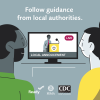Messages to share
Include these key messages about hurricane preparedness when creating content for social media posts. Visit the Hurricane Season Preparedness Digital Toolkit page for additional resources and ready-to-use social media posts.
Hashtag: #HurricanePrep, #HurricaneStrong
- Hurricanes are not just a coastal problem, find out how rain, wind, water could happen where you live so you can start preparing now.
- Discuss your hurricane emergency plan with your household.
- Have enough supplies for your household, include medication, disinfectant supplies, cloth face coverings, pet supplies in your go bag or car trunk.
- If you or anyone in your household is an individual with a disability identify if you may need additional help during an emergency.
- You may have to evacuate quickly due to a hurricane so make sure to know your local evacuation zone.
- Download the FEMA app and receive real-time alerts from the National Weather Service for up to five locations nationwide.
- Review your insurance policies and make sure personal documents (like ID) are up to date.
- Prepare your business with a continuity plan to continue operating when disaster strikes.
















